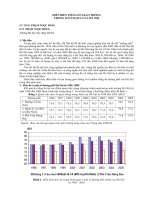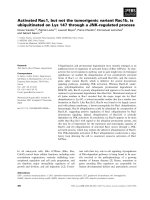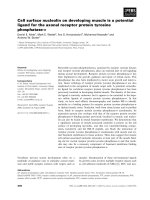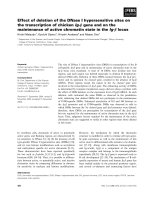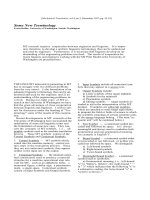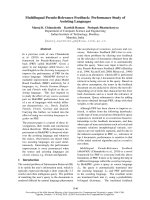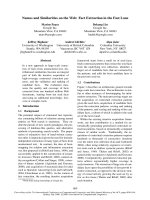Báo cáo khoa học: "Multilingual Legal Terminology on the Jibiki Platform: The LexALP Project" docx
Bạn đang xem bản rút gọn của tài liệu. Xem và tải ngay bản đầy đủ của tài liệu tại đây (428.24 KB, 8 trang )
Proceedings of the 21st International Conference on Computational Linguistics and 44th Annual Meeting of the ACL, pages 937–944,
Sydney, July 2006.
c
2006 Association for Computational Linguistics
Multilingual Legal Terminology on the Jibiki Platform:
The LexALP Project
Gilles S
´
erasset, Francis Brunet-Manquat
Universit
´
e Joseph Fourier,
Laboratoire CLIPS-IMAG, BP 53
38041 Grenoble Cedex 9 - France,
Elena Chiocchetti
EURAC Research
Viale Druso 1
39100 Bozen/Bolzano - Italy
Abstract
This paper presents the particular use of
“Jibiki” (Papillon’s web server develop-
ment platform) for the LexALP
1
project.
LexALP’s goal is to harmonise the ter-
minology on spatial planning and sustain-
able development used within the Alpine
Convention
2
, so that the member states
are able to cooperate and communicate
efficiently in the four official languages
(French, German, Italian and Slovene). To
this purpose, LexALP uses the Jibiki plat-
form to build a term bank for the con-
trastive analysis of the specialised termi-
nology used in six different national legal
systems and four different languages. In
this paper we present how a generic plat-
form like Jibiki can cope with a new kind
of dictionary.
1 Introduction
One of the most time-consuming hindrances to
supranational law drafting and convention nego-
tiation is the lack of understanding among nego-
tiators and technical writers. This is not only due
to the fact that different languages are involved,
but mainly to the inherent differences in the legal
systems. Countries that speak the same language
(like France and part of Switzerland) may use the
same word to represent different legal concepts
3
,
1
Legal Language Harmonisation System for Environment
and Spatial Planning within the Multilingual Alps
2
3
E.g.: In the German-speaking province of Bolzano Italy
the Landeshauptmann is the president of the provincial coun-
cil, with much more limited competence that the Austrian
Landeshauptmann, who is head of one of the states (Bundes-
land) that are part of the Austrian federation.
as defined in their respective legal traditions. The
same concept may be referred to in different ways
according to the legal system
4
. Also, terms that
may superficially seem to be translations of each
other can represent different legal notions
5
.
In order to concretely address these problems,
several institutions representing translators, ter-
minologists, legal experts and computational lin-
guists joined in the LexALP project, co-funded by
EU’s INTERREG IIIb Alpine Space programme.
The objective of the project is to compare the spe-
cialised terminology of six different national legal
systems (Austria, France, Germany, Italy, Switzer-
land and Slovenia) and three supranational sys-
tems (EU law, international law and the particu-
lar framework of the Alpine Convention) in the
four official languages of the Al-pine Convention,
which is an international framework agreement
signed by all countries of the Alpine arc and the
EU. This contrastive analysis serves as a basis for
the work of a group of experts (the Harmonising
Group) who will determine translation equivalents
in French, Italian, German and Slovene (one-to-
one correspondence) in the fields of spatial plan-
ning and sustainable development for use within
the Convention, thus optimising the understanding
between the Alpine states at supranational level.
The tools that are to be developed for these ob-
jectives comprise a corpus bank and a term bank.
The corpus bank is developed by adapting the
bistro system (Streiter et al., 2006; Streiter et al.,
2004). The term bank is based on the Jibiki plat-
4
See for instance the European Union use of chien drogue
while French legislation calls them chien renifleur.
5
For example, in Italy an elezione suppletiva is commonly
held whenever an elected deputy or senator either resigns or
dies. In Germany in such cases the first non-elected candidate
is called to parliament. Ersatzwahlen are a rare phenomenon,
foreseen in some very specific cases.
937
form (Mangeot et al., 2003; S
´
erasset, 2004).
This paper details the way the Jibiki platform is
used in order to cope with a new dictionary struc-
ture. The platform provides dictionary access and
edition services without any new and specific de-
velopment.
After a brief overview of the Jibiki platform, we
describe the choices made by the LexALP team for
the structure and organisation of their term bank.
Then, we show how this structure is described us-
ing Jibiki metadata description languages. Finally,
we give some details on the resulting LexALP In-
formation System.
2 Jibiki, The Papillon Dictionary
Development Platform
2.1 Overview
The Jibiki platform has been designed to support
the collaborative development of multilingual dic-
tionaries. This platform is used as the basis of the
Papillon project web site
6
.
This platform offers several services to its users:
• access to many different dictionaries from a
single easy to use query form,
• advance search for particular dictionary en-
tries through an advanced search form,
• creation and edition of dictionary entries.
What makes the Jibiki platform quite unique is
the fact that it provides these services regardless of
the dictionary structure. In other words it may be
used by any dictionary builder to give access and
collaboratively edit any dictionary, provided that
the resulting dictionary will be freely accessible
online.
2.2 Jibiki Platform Architecture
The Jibiki platform is a framework used to set up
a web server dedicated to the collaborative devel-
opment of multilingual dictionaries. All services
provided by the platform are organised as classi-
cal 3-tier architectures with a presentation layer
(in charge of the interface with users), a business
layer (which provides the services per se) and a
data layer (in charge of the storage of persistent
data).
In order to adapt the Jibiki platform to a new
dictionary, the dictionary manager does not have
6
/>Papillon Application (java + enhydra
presentation
layer
serveur
HTTP
(apache)
Relational database
(PostgreSQL)
XML-UTF8
HTML
CSS
javascript
+
CGI
WML
xhtml
chtml
business layer data layer
J
D
B
C
Lexie
axie
Dico
Historique
Utilisateur
Data
validation
Mailing list
archive
Users/Groups
Contributions
management
Volume
Information
sharing
requests
management
Information
Message
Figure 1: The Jibiki platform general architecture
to write specific java code nor specific dynamic
web pages. The only necessary information used
by the platform consists in:
• a description of the dictionary volumes and
their relations,
• a mapping between the envisaged dictionary
structure and a simple hypothetical dictionary
structure (called CDM)
7
,
• the definition of the XML structure of each
envisaged dictionary volume by way of XML
schemas,
• the development of a specific edition in-
terface as a standard xhtml form (that can
be adapted from an automatically generated
draft).
3 The LexALP Terminology Structure
3.1 Overview
The objective of the LexALP project is to com-
pare the specialised terminology of six different
national legal systems and three supranational sys-
tems in four different languages, and to harmonise
it, thus optimising communication between the
Alpine states at supranational level. To achieve
this objective, the terminology of the Alpine Con-
vention is described and compared to the equiva-
lent terms used in national legislation. The result-
ing terminology entries feed a specific term bank
that will support the harmonisation work.
As the project deals with legal terms, which re-
fer to concepts that are proper of the considered
national law or international convention, equiva-
lence problems are the norm, given that concepts
are not “stable” between the different national leg-
islations. Standard terminology techniques for
other fields can not be applied to the field of law,
where the standardisation approach (Felber, 1987;
7
This mapping is sufficient for simple dictionary access
938
Felber, 1994) is not applicable. For this, we chose
to use “acceptions” as they are defined in the Pa-
pillon dictionary (S
´
erasset, 1994) to represent the
equivalence links between concepts of the differ-
ent legal systems (Arntz, 1993).
Italian
Slovene
German
French
inneralpiner Verkehr
znotrajalpski promet
transport intra-alpin
circulation intra-alpine
trafic intra-alpin
traffico intraalpino
trasporto intraalpino
Figure 2: An Alpine Convention concept in four
languages
The example given in figure 2 shows a concept
defined in the Alpine Convention. This concept
has the same definition in the four languages of
the Alpine Convention but is expressed by differ-
ent denominations. The Alpine Convention also
uses the terms “circulation intra-alpine” or “trans-
port intra-alpin” which are identified as synonyms
by the terminologist.
This illustrates the first goal of the LexALP
project. In different texts, the same concept may
be realised by different terms in the same lan-
guage. This may lead to inefficient communica-
tion. Hence, a single term has to be determined
as part of a harmonised quadruplet of transla-
tion equivalents. The other denominations will be
represented in the term bank as non-harmonised
synonyms in order to direct drafting and translat-
ing within the Alpine Convention towards a more
clear and consistent terminology use for interlin-
gual and supranational communication.
In this example, the lexicographers and jurists
did not identify any existing concept in the differ-
ent national laws that could be considered close
enough to the concept analysed. This is coherent
with the minutes from the French National Assem-
bly which clearly states that the term “trafic intra-
alpin” (among others) should be clarified by a dec-
laration to be added to the Alpine Convention.
Figure 3 shows an analogous quadrilingual ex-
ample where the Alpine Convention concept may
be related to a legal term defined in the French
laws. In this example the French term is distin-
guished from the Alpine Convention terms, be-
cause these concepts belong to different legal sys-
Italian
Slovene
German
French
principio di precauzione
Vorsorgeprinzip
nacelo preventive
principe de précaution
principe de précaution
Figure 3: A quadrilingual term extracted from the
Alpine Convention with reference to its equivalent
at French national level
tems (and are not identically defined in them).
Hence, the terminologists created distinct accep-
tions, one for each concept. These acceptions are
related by a translation link.
This illustrates the second goal of the project,
which is to help with the fine comprehension of the
Alpine Convention and with the detailed knowl-
edge necessary to evaluate the implementation and
implementability of the convention in the different
legal systems.
As a by-product of the project, one can see that
there is an indirect relation between concepts from
different national legal systems (by way of their
respective relation to the concepts of the Alpine
Convention). However, establishing these indi-
rect relations is not one of the main objectives of
the LexALP project and would require more direct
contrastive analysis.
3.2 Macro- and Micro- Structures
The LexALP term bank consists in 5 volumes
(for French, German, Italian, Slovene and English)
containing all term descriptions (grammatical in-
formation, definition, contexts etc.). The transla-
tion links are established through a central accep-
tion volume. Figure 2 and 3 show examples of
terms extracted from the Alpine Convention, syn-
onymy links in the French and Italian volumes,
as well as inter-lingual relations by way of accep-
tions.
All language volumes share the same mi-
crostructure. This structure is stored in XML.
Figure 4 shows the xml structure of the French
term “trafic intra-alpin”, as defined in the Alpine
Convention. The term entry is associated to a
unique identifier used to establish relations be-
tween volume entries. Each term entry belongs
to one (and only one) legal system. The exam-
ple term belongs to the Alpine Convention legal
939
<entry id="fra.trafic_intra-alpin.1010743.e"
lang="fra"
legalSystem="AC"
process_status="FINALISED"
status="HARMONISED">
<term>trafic intra-alpin</term>
<grammar>n.m.</grammar>
<domain>Transport</domain>
<usage frequency="common"
geographical-code="INT"
technical="false"/>
<relatedTerm isHarmonised="false"
relationToTerm="Synonym"
termref="">
transport intra-alpin
</relatedTerm>
<relatedTerm isHarmonised="false"
relationToTerm="Synonym"
termref="">
circulation intra-alpine
</relatedTerm>
<definition>
[T]rafic constitu
´
e de trajets ayant leur
point de d
´
epart et/ou d’arriv
´
ee
`
a l’int
´
e-
rieur de l’espace alpin.
</definition>
<source url="">Prot. Transp., art. 2</source>
<context url="http://www ">
Des projets routiers
`
a grand d
´
ebit pour
le trafic intra-alpin peuvent
ˆ
etre r
´
ealis
´
es,
si [ ].
</context>
</entry>
Figure 4: XML form of the term “trafic intra-
alpin”.
system
8
(code AC). The set of known legal sys-
tems includes of course countries belonging to the
Alpine Space (Austria, France, Germany, Italy,
Slovenia and Switzerland
9
) but also international
treaties or conventions. The entry also bears the
information on its status (harmonised or rejected)
and its process status (to be processed, provision-
ally processed or finalised).
The term itself and its part of speech is also
given, with the general domain to which the term
belongs, along with some usage notes. In these us-
age notes, the attribute geographical-code
allows for discrimination between terms defined
in national (or federal) laws and terms defined in
regional laws as in some of the countries involved
legislative power is distributed at different levels.
Then the term may be related to other terms.
These relations may lead to simple strings of
texts (as in the given example) or to autonomous
term entries in the dictionary by the use of the
termref attribute. The relation itself is specified
in the relationToTerm attribute. The current
schema allows for the representation of relations
8
Strictly speaking, the Alpine Convention does not con-
stitute a legal system per se.
9
Also Liechtenstein and Monaco are parties to the Alpine
Convention, however, their legal systems are not terminolog-
ically processed within LexALP.
between concepts (synonymy, hyponymy and hy-
peronymy), as well as relations between graphies
(variant, abbreviation, acronym, etc.).
Then, a definition and a context may be given.
Both should be extracted from legal texts, which
must be identified in the source field.
An interlingual acception (or axie) is a place
holder for relations. Each interlingual acception
may be linked to several term entries in the lan-
guage volumes through termref elements and
to other interlingual acceptions through axieref
elements, as illustrated in figure 5.
<axie id="axi 1011424.e">
<termref
idref="ita.traffico_intraalpino.1010654.e"
lang="ita"/>
<termref
idref="fra.trafic_intra-alpin.1010743.e"
lang="fra"/>
<termref
idref="deu.inneralpiner_Verkehr.1011065.e"
lang="deu"/>
<termref
idref="slo.znotrajalpski_promet.1011132.e"
lang="slo"/>
<axieref idref=""/>
<misc></misc>
</axie>
Figure 5: XML form of the interlingual acception
illustated in figure 2.
4 LexALP Information System
4.1 Overview
Building such a term bank can only be envisaged
as a collaborative work involving terminologists,
translators and legal experts from all the involved
countries. Hence, the LexALP consortium has set
up a centralised information system that is used to
gather all textual and terminological data.
This information system is organized in two
main parts. The first one is dedicated to corpus
management. It allows the users to upload legal
texts that will serve to bootstrap the terminology
work (by way of candidate term extraction) and
to let terminologists find occurrences of the term
they are working on, in order for them to provide
definitions or contexts.
The second part is dedicated to terminology
work per se. It has been developed with the Jibiki
platform described in section 2. In this section, we
show the LexALP Information System functional-
ity, along with the metadata required to implement
it with Jibiki.
940
4.2 Dictionary Browsing
The first main service consists in browsing the cur-
rently developed dictionary. It consists in two dif-
ferent query interfaces (see figures 6 and 7) and a
unique result presentation interface (see figure 10).
Figure 6: Simple search interface present on all
pages of the LexALP Information System
<dictionary-metadata
[ ]
d:category="multilingual"
d:fullname="LexALP multilingual Term Base"
d:name="LexALP"
d:owner="LexALP consortium"
d:type="pivot">
<languages>
<source-language d:lang="deu"/>
<source-language d:lang="fra"/>
<target-language d:lang="deu"/>
<target-language d:lang="fra"/>
[ ]
</languages>
[ ]
<volumes>
<volume-metadata-ref name="LexALP_fra"
source-language="fra"
xlink:href="LexALP_fra-metadata.xml"/>
<volume-metadata-ref name="LexALP_deu"
source-language="deu"
xlink:href="LexALP_deu-metadata.xml"/>
[ ]
<volume-metadata-ref name="LexALP_axi"
source-language="axi"
xlink:href="LexALP_axi-metadata.xml"/>
</volumes>
<xsl-stylesheet name="LexALP" default="true"
xlink:href="LexALP-view.xsl"/>
<xsl-stylesheet name="short-list"
xlink:href="short-list-view.xsl"/>
</dictionary-metadata>
Figure 8: Excerpt of the dictionary descriptor
In the provided examples, the user of the sys-
tem specifies an entry (a term), or part of it, and
a language in which the search is to be done. The
expected behaviour may only be achieved if :
• the system knows in which volume the search
is to be performed,
• the system knows where, in the volume entry,
the headword is to be found,
• the system is able to produce a presentation
for the retrieved XML structures.
However, as the Jibiki platform is entirely in-
dependent of the underlying dictionary structure
<volume-metadata
[ ]
dbname="lexalpfra"
dictname="LexALP"
name="LexALP_fra"
source-language="fra">
<cdm-elements>
<cdm-entry-id index="true"
xpath="/volume/entry/@id"/>
<cdm-headword d:lang="fra" index="true"
xpath="/volume/entry/term/text()"/>
<cdm-pos d:lang="fra" index="true"
xpath="/volume/entry/grammar/text()"/>
[ ]
</cdm-elements>
<xmlschema-ref xlink:href="lexalp.xsd"/>
<template-entry-ref
xlink:href="lexalp_fra-template.xml"/>
<template-interface-ref
xlink:href="lexalp-interface.xhtml"/>
</volume-metadata>
Figure 9: Excerpt of a volume descriptor
(which makes it highly adaptable), the expected
result may only be achieved if additional metadata
is added to the system.
These pieces of information are to be found in
the mandatory dictionary descriptor. It consists
in a structure defined in the Dictionary Metadata
Language (DML), as set of metadata structures
and a specific XML namespace defined in (Man-
geot, 2001).
Figure 8 gives an excerpt of this descriptor. The
metadata first identify the dictionary by giving it
a name and a type. In this example the dictionary
is a pivot dictionary (DML also defines monolin-
gual and bilingual dictionary types). The descrip-
tor also defines the set of source and target lan-
guages. Finally, the dictionary is defined as a set
of volumes, each volume being described in an-
other file. As the LexALP dictionary is a pivot
dictionary, there should be a volume for the artifi-
cial language axi, which is the pivot volume.
Figure 9 shows an excerpt of the description of
the French volume of the LexALP dictionary. Af-
ter specifying the name of the dictionary, the de-
scriptor provides a set of cdm-elements. These el-
ements are used to identify standard dictionary el-
ements (that can be found in several dictionaries)
in the specific dictionary structure. For instance,
the descriptor tells the system that the headword of
the dictionary (cdm-headword) is to be found
by applying the specified xpath
10
to the dictionary
structure.
With this set of metadata, the system knows
that:
10
an xpath is a standard way to extract a sub-part of any
XML structure
941
Figure 7: Advanced search interface
• requests on French should be directed to the
LexALP fra volume,
• the requested headword will be found in the
text of the term element of the volume
entry element,
Hence, the system can easily perform a request
and retrieve the desired XML entries. The only
remaining step is to produce a presentation for
the user, based on the retrieved entries. This is
achieved by way of a xsl
11
stylesheet. This
stylesheet is specified either on the dictionary level
(for common presentations) or on the volume level
(for volume specific presentation).
In the given example, the dictionary adminis-
trator provided two presentations called LexALP
(the default one, as shown in figure 10) and
short-list, both of them defined in the dic-
tionary descriptor.
This mechanism allows for the definition of pre-
sentation outputs in xhtml (for online browsing)
or for presentation output in pdf (for dictionary
export and print).
4.3 Dictionary Edition
The second main service provided by the Jibiki
platform is to allow terminologists to collabora-
tively develop the envisaged dictionary. In this
sense, Jibiki is quite unique as it federates, on the
very same platform the construction and diffusion
of a structured dictionary.
As before, Jibiki may be used to edit any dictio-
nary. Hence, it needs some metadata information
in order to work:
• the complete definition of the dictionary entry
structures by way of an XML schema,
• a template describing an empty entry struc-
ture,
11
XSL is a standard way to transform an XML structure
into another structure (XML or not).
Current XML
structure
Empty
XHTML form
Instanciate Form
Instanciated
XHTML form
Online edition
Network
CGI decoding
Figure 11: Basic flow chart of the editing service
• a xhtml form used to edit a dictionary entry
structure (which can be adapted from an au-
tomatically generated one).
When this information is known, the Jibiki plat-
form provides a specific web page to edit a dictio-
nary entry structure. As shown in figure 11, the
XML structure is projected into the given empty
XHTML form. This form is served as a standard
web page on the client browser. After manual edit-
ing, the resulting form is sent back to the Jibiki
platform as CGI
12
data. The Jibiki platform de-
codes this data and modifies the edited XML struc-
ture accordingly. Then the process iterates as long
as necessary. Figure 12 shows an example of such
a dynamically created web page.
After each update, the resulting XML structure
is stored in the dictionary database. However, it
is not available to other users until it is marked as
finished by the contributor (by clicking on the
save button). If the contributor leaves the web
page without saving the entry, he will be able to
retrieve it and finish his contribution later.
12
Common Gateway Interface
942
Figure 10: Query result presentation interface
Figure 12: Edition interface of a LexALP French entry
943
At each step of the contribution (after each up-
date) and at each step of dictionary editing (after
each save), the previous state is saved and the con-
tributor (or the dictionary administrator) is able to
browse the history of changes and to revert the en-
try to a previous version.
5 Conclusion
In this article we give some details on the way the
Jibiki platform allows the diffusion and the online
editing of a dictionary, regardless of his structure
(monolingual, bilingual (directed or not) or multi-
lingual (multi-bilingual or pivot based)).
Initially developed to support the editing of the
Papillon multilingual dictionary
13
, the Jibiki plat-
form proved useful for the development of other
very different dictionaries. It is currently used for
the development of the GDEF (Grand Dictionnaire
Estonien-Franc¸ais) project
14
an Estonian French
bilingual dictionary. This article also shows the
use of the platform for the development of a Eu-
ropean term bank for legal terms on spatial plan-
ning and sustainable development in the LexALP
project.
Adapting the Jibiki platform to a new dictio-
nary requires the definition of several metadata in-
formation, taking the form of several XML files.
While not trivial, this metadata definition does not
require any competence in computer development.
This adaptation may therefore also be done by ex-
perimented linguists. Moreover, when the dictio-
nary microstructure needs to evolve, this evolu-
tion does not require any programming. Hence the
Jibiki platform gives linguists great liberty in their
decisions.
Another positive aspect of Jibiki is that it inte-
grates diffusion and editing services on the same
platform. This allows for a tighter collaboration
between linguists and users and also allows for the
involvement of motivated users to the editing pro-
cess.
The Jibiki platform is freely available for use by
any willing team of lexicographer/terminologists,
provided that the resulting dictionary data will be
freely available for online browsing.
In this article, we also presented the choices
made by the LexALP consortium to structure a
term bank used for the description and harmonisa-
tion of legal terms in the domain of spacial plan-
13
/>14
/>ning and sustainable development of the Alpine
Space. In such a domain, classical techniques
used in multilingual terminology cannot be used
as the term cannot be defined by reference to a sta-
ble/shared semantic level (each country having its
own set of non-equivalent legal concepts).
References
Reiner Arntz. 1993. Terminological equivalence
and translation. In H. Sonneveld and K. Loen-
ing, editors, Terminology. Applications in Interdisci-
plinary Communication, pages 5–19. Amsterdam et
Philadelphia, John Benjamins Publishing Company.
Helmut Felber, 1987. Manuel de terminologie. UN-
ESCO, Paris.
Helmut Felber. 1994. Terminology research: Its rela-
tion to the theory of science. ALFA, 8(7):163–172.
Mathieu Mangeot, Gilles S
´
erasset, and Mathieu
Lafourcade. 2003. Construction collaborative d’une
base lexicale multilingue, le projet Papillon. TAL,
44(2):151–176.
Mathieu Mangeot. 2001. Environnements centralis
´
es
et distribu
´
es pour lexicographes et lexicologues en
contexte multilingue. Th
`
ese de nouveau doctorat,
sp
´
ecialit
´
e informatique, Universit
´
e Joseph Fourier
Grenoble I, Septembre.
Gilles S
´
erasset. 1994. Interlingual lexical organi-
sation for multilingual lexical databases in nadia.
In Makoto Nagao, editor, COLING-94, volume 1,
pages 278–282, August.
Gilles S
´
erasset. 2004. A generic collaborative plat-
form for multilingual lexical database development.
In Gilles S
´
erasset, editor, COLING 2004 Multilin-
gual Linguistic Resources, pages 73–79, Geneva,
Switzerland, August 28. COLING.
Oliver Streiter, Leonhard Voltmer, Isabella Ties, and
Natascia Ralli. 2004. BISTRO, the online plat-
form for terminology management: structuring ter-
minology without entry structures. In The transla-
tion of domain specific languages and multilingual
terminology, number 3 in Linguistica Antverpien-
sia New Series. Hoger Instituut voor Vertalers en
Tolken, Hogeschool Antwerpen.
Oliver Streiter, Leonhard Voltmer, Isabella Ties, Natas-
cia Ralli, and Verena Lyding. 2006. BISTRO: Data
structure, term tools and interface. Terminology Sci-
ence and Research, 16.
944
